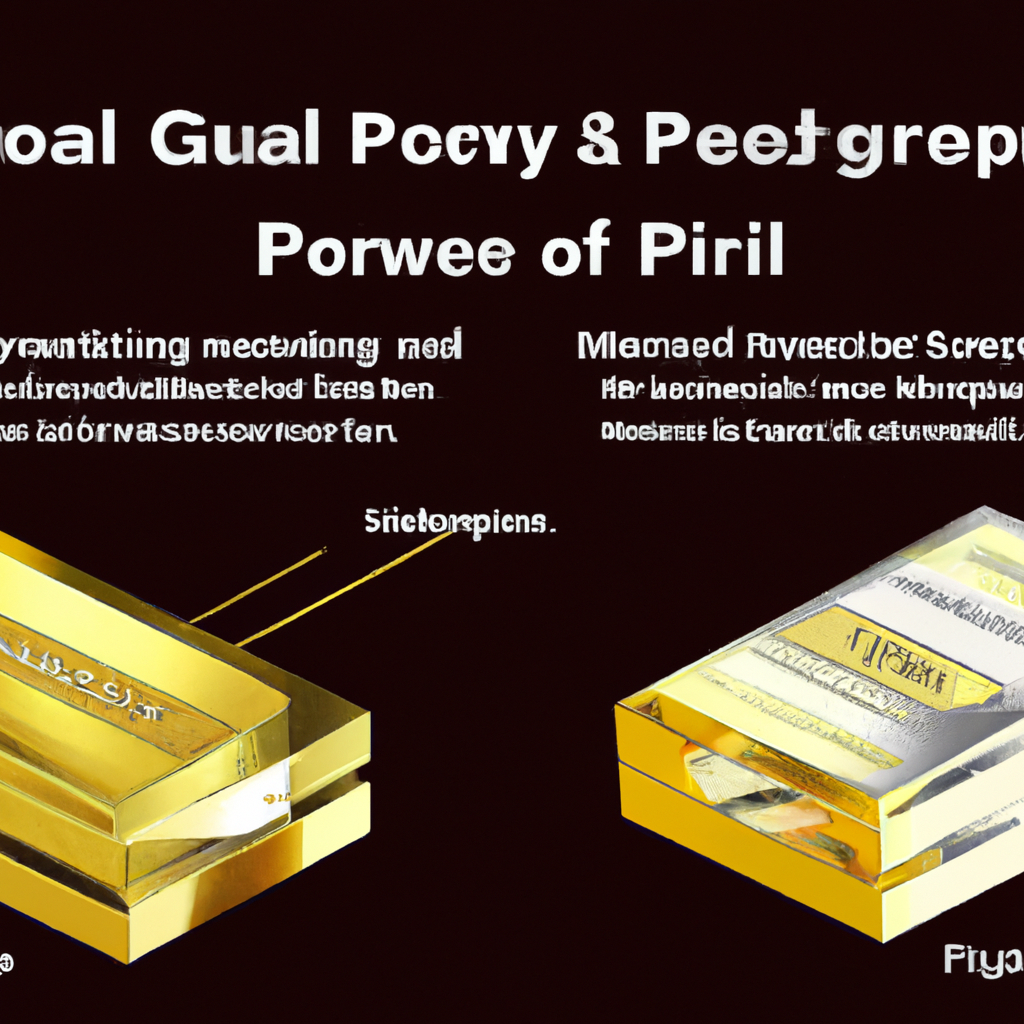Imagine holding a shiny, gleaming piece of gold in your hand. This tangible piece of wealth known as physical gold could be part of your portfolio. As an investor, you may also be considering paper gold, an investment that represents gold ownership without the immediate benefits of possession. As you embark on your gold investment journey, this article, “Physical Gold Vs. Paper Gold: Understanding The Investment Options,” aims to offer you insightful knowledge and comparisons between these two different types of gold investments to help you make an informed decision.
The Definition of Physical Gold
What is Physical Gold?
Physical gold is the tangible form of gold. It comes in various shapes and sizes, including bullion bars, coins, or jewelry. When you purchase physical gold, you obtain the actual gold metal, which you can hold in your hand. This ownership implies that you have complete control over this asset unless you decide to sell or transfer it to someone else.
Different Forms of Physical Gold
As mentioned previously, physical gold comes in various forms. These can be coins, bullion bars, and even jewelry. Gold coins are minted by governments and are often used by investors, while bullion bars are larger and preferred by serious investors and institutions. Lastly, gold jewelry is often bought for ornamental use but can also be regarded as an investment form.
Key Features and Characteristics of Physical Gold
Physical gold is a highly prized precious metal. It has a unique combination of features that make it desirable. Gold is highly durable – it doesn’t corrode or tarnish over time. It’s also quite scarce, which adds to its value. One of the key features of physical gold is that it holds intrinsic value, which means it will always have worth due to its physical properties and rarity. Furthermore, it offers liquidity as it can be sold almost anywhere in the world.
The Definition of Paper Gold
What is Paper Gold?
Paper Gold, contrary to its name, is not made of paper but represents gold investments that don’t entail ownership of the physical metal. Instead, these are financial instruments that track the price of gold. These can be in the form of Exchange-Traded Funds (ETFs), gold certificates, gold mining stocks, or gold futures contracts.
Different Forms of Paper Gold
There’s a variety of paper gold forms. Gold ETFs represent a share of gold held by the fund, and their price often tracks the price of gold. Gold mining stocks offer exposure to gold prices, though they also reflect the profitability and stability of the mining company. Gold certificates are essentially receipts that validate the holder’s ownership of a specific amount of gold stored elsewhere. And lastly, gold futures are contracts to buy or sell gold at a specific price on a future date.
Key Features and Characteristics of Paper Gold
Paper gold’s key features lie in its convenience and flexibility. Investors can gain exposure to gold’s price movements without dealing with the hassles of storage and protection. It offers higher liquidity than physical gold since it can be sold in financial markets during trading hours. Paper gold is accessible to a wide range of investors, and particular types like ETFs and futures can provide leverage, potentially amplifying gains (and losses).

How Does Physical Gold Work as an Investment?
Benefits of Investing in Physical Gold
Investing in physical gold offers a plethora of benefits. Firstly, gold is seen as a hedge against inflation – when the value of money decreases, gold tends to appreciate. Secondly, owning physical gold provides a safety net during periods of financial uncertainty or crises. Physical gold lacks default risk since there’s no counterparty involved. Moreover, physical gold generally remains valuable and never becomes worthless.
Risks and Challenges of Investing in Physical Gold
However, investing in physical gold carries risks and challenges as well. These include storage difficulties and costs associated with security measures. There are also risks of theft. Furthermore, physical gold doesn’t provide interest or dividends, unlike financial assets such as bonds or stocks. Lastly, gold prices can be volatile and may undergo periods where they decline in value.
How to Buy and Store Physical Gold
To buy physical gold, you may visit gold dealers, mints, or sometimes even banks. After purchasing, one critical aspect to consider is storage. You could store the gold at home in a secure safe, but this places the burden of security on you. Alternatively, you might consider a bank safety deposit box or professional storage services, which offer insurance and high-security measures.
How Does Paper Gold Work as an Investment?
Benefits of Investing in Paper Gold
Investing in paper gold provides a convenient and secure way to gain exposure to gold prices. One main advantage is you don’t need to worry about storage and security. Trading paper gold is much more straightforward than selling physical gold, providing more excellent liquidity. Some paper gold investments, like mining stocks, may even pay dividends, something physical gold doesn’t offer.
Risks and Challenges of Investing in Paper Gold
Despite its advantages, paper gold investment comes with its own set of risks. The performance of some paper gold forms like mining stocks depends not only on gold price but also on the management and operations of mining companies. Moreover, there’s counterparty risk involved in paper gold investments – for instance, if the issuer of your gold ETF or certificate faces financial trouble. Lastly, paper gold may not provide the same psychological satisfaction of owning and holding actual gold.
How to Purchase Paper Gold
There are different avenues to buy paper gold. You can buy gold ETFs through a brokerage account, similar to how you might purchase stocks. Gold certificates can typically be obtained from certain banks or dealers. If you’re interested in gold mining stocks, these can be purchased like any other stock on a stock exchange. Gold futures, however, are a more complex financial instrument and are often traded through commodities or futures brokers.

Cost and Accessibility of Physical Gold and Paper Gold
Cost of Physical Gold and Paper Gold
The cost of physical gold primarily depends on the current spot price of gold in the market. There might also be additional costs of fabrication, shipping, and insurance. Conversely, the cost of paper gold also hinges on gold’s current price, but it may come with its own set of fees. For example, ETFs typically charge an annual expense ratio, and brokering accounts may charge transaction fees.
Accessibility of Physical Gold and Paper Gold
Physical and paper gold are both quite accessible to the average investor. Physical gold can be obtained from a variety of dealers or mints, and even online platforms. Paper gold, on the other hand, can be purchased through financial institutions or brokerage accounts, which are also widely accessible.
Trading Time for Physical Gold and Paper Gold
While you can theoretically sell physical gold 24/7, realistically, you are limited by dealer operation hours. Paper gold, on the other hand, can be traded during normal trading hours on whatever trading platform or exchange they’re listed.
Security Concerns in Physical Gold and Paper Gold
Security Measures for Physical Gold
Physical gold requires specific security measures to prevent theft. If opting for home storage, consider a high-quality, robust and secure safe. If preferring professional storage options, ensure that they’re strongly vetted, and proper insurance is in place.
How Secure are Paper Gold Investments?
With paper gold investing, the concern is not about theft but rather about the financial solidity of the entity backing your investment. It’s essential to research the stability of the institution issuing the paper gold. Well-established ETFs or mining companies are traditionally safer than smaller or newer entities.
Comparative Security of Both Investment Options
When weighed against each other, physical gold offers the benefit of direct ownership without relying on another party’s financial stability. Paper gold investments, while carrying counterparty and operational risks, remove the concerns associated with physical theft or loss.

Impact of Market Fluctuations on Physical and Paper Gold
How Market Fluctuations Impact the Price of Physical Gold
Gold prices are susceptible to various market factors – interest rates, geopolitical instability, and economic performance, among others. During periods of market volatility or weakening currencies, gold often performs well as investors seek a ‘safe-haven’.
Impact of Market Fluctuations on Paper Gold
Paper gold tracks the price of physical gold, so market fluctuations affect them similarly. However, some types of paper gold, like mining stocks, can also be impacted by company-specific news or the broader stock market trends.
Strategies to Mitigate Risks from Market Fluctuations
As with any investment, diversification is one of the best ways to mitigate risks. Instead of putting all your money in gold, consider spreading your investments across various asset types to minimize the impacts of market fluctuations.
Taxation and Legal Aspects of Physical and Paper Gold Investments
Tax Implications of Investing in Physical Gold
In many jurisdictions, physical gold is subject to capital gains tax when sold for a profit. However, these laws vary significantly by country, so it’s essential to familiarize yourself with your local taxation policies.
Legal Aspects of Owning and Trading Physical Gold
The legality of owning and trading physical gold varies by country. In some places, it may be illegal to own large amounts of gold without certain permissions. Consult a local law professional to understand the legal implications.
Tax and Legal Considerations for Paper Gold Investments
Like physical gold, paper gold is often subject to capital gains tax. However, the tax treatment may vary depending on the type of paper gold investment. Legal considerations for paper gold are generally less concerning than for physical gold, but understanding the regulations surrounding these securities is crucial.

Performance Comparison of Physical and Paper Gold
Historical Performance of Physical Gold
Historically, physical gold has been a reliable store of value, maintaining its worth over the long term. It has also seen periods of significant price appreciation, particularly during economic crises.
Historical Performance of Paper Gold
The performance of paper gold largely mirrors that of physical gold due to its price-tracking nature. However, certain forms of paper gold, like gold mining stocks, can vary greatly in performance based on the company’s effectiveness.
Comparing the Returns of Physical and Paper Gold Investments
While both physical and paper gold have their merits, the returns largely depend on the timing of the investment and market conditions. Broadly speaking, they have largely offered positive returns over the long term.
Deciding Between Physical and Paper Gold: Factors to Consider
Understanding Your Investment Goals
Your investment goals play a crucial role in deciding between physical and paper gold. If you’re looking for a tangible asset to hedge against turmoil or inflation, physical gold could be an excellent choice. Conversely, if you’re after easy trading and no storage worries, paper gold will be more suitable.
Assessing Your Risk Tolerance
When choosing between physical and paper gold, understanding your risk tolerance is essential. Physical gold carries the risk of theft, while paper gold carries counterparty risk. If you can’t afford to take on much risk, you’ll need to weigh these factors carefully.
Diversification and Asset Allocation Considerations
Finally, a key decision factor is the role gold will play in your portfolio. Both physical and paper gold can serve as a diversifier in your portfolio but in different ways. By understanding these different strengths and weaknesses, you can choose the option that’s best aligned with your overall investment strategy. In conclusion, both physical and paper gold have unique attributes that can make them valuable additions to your portfolio. The best choice depends on your individual circumstances, investment goals, and risk tolerance.









